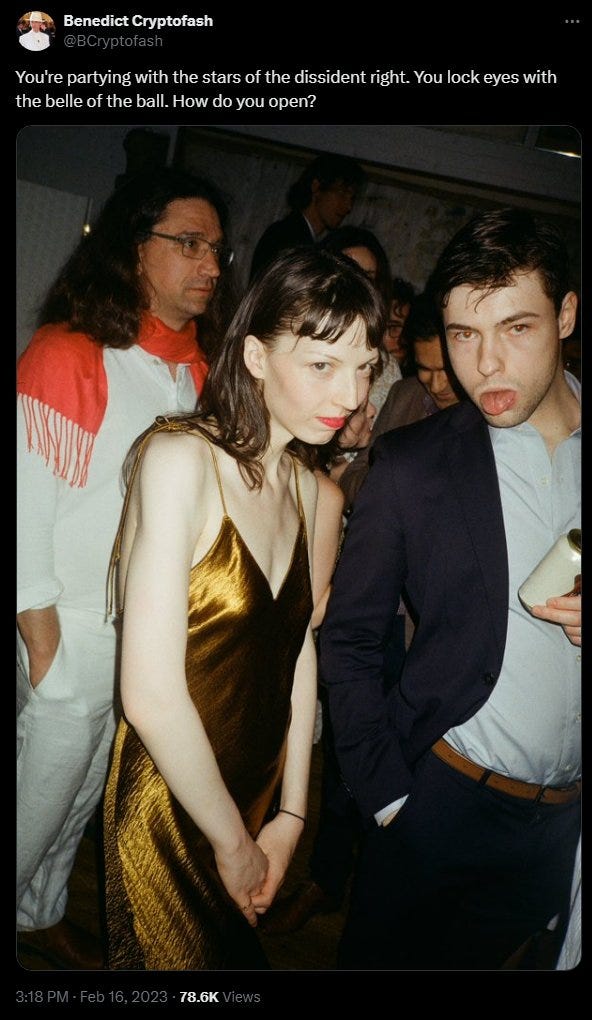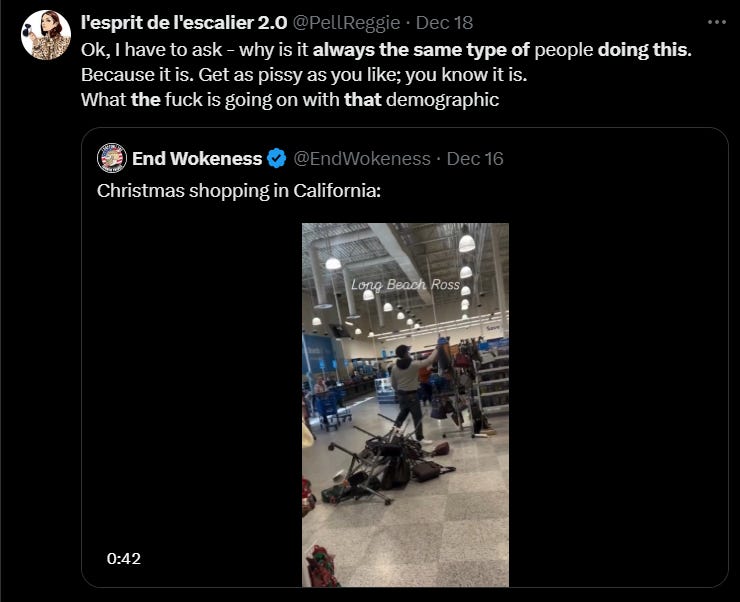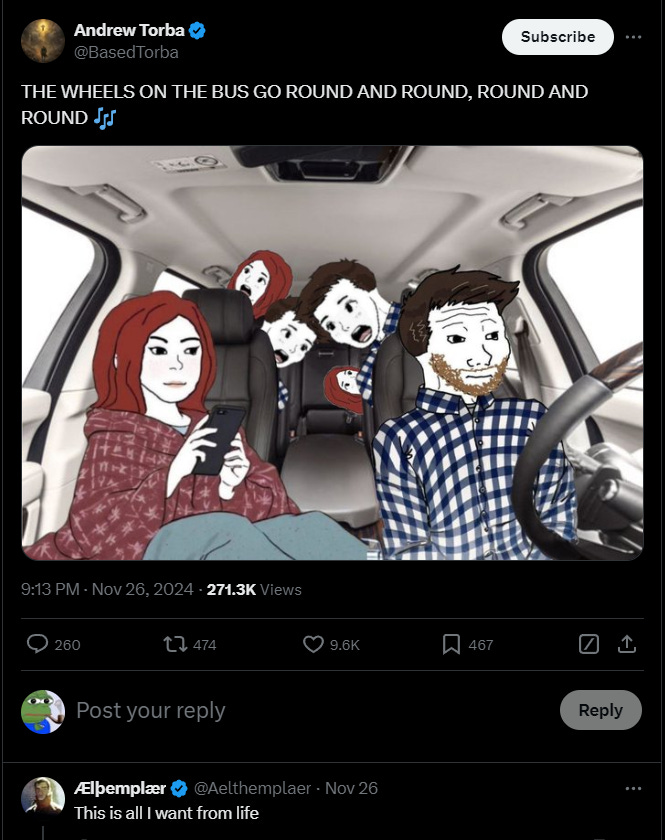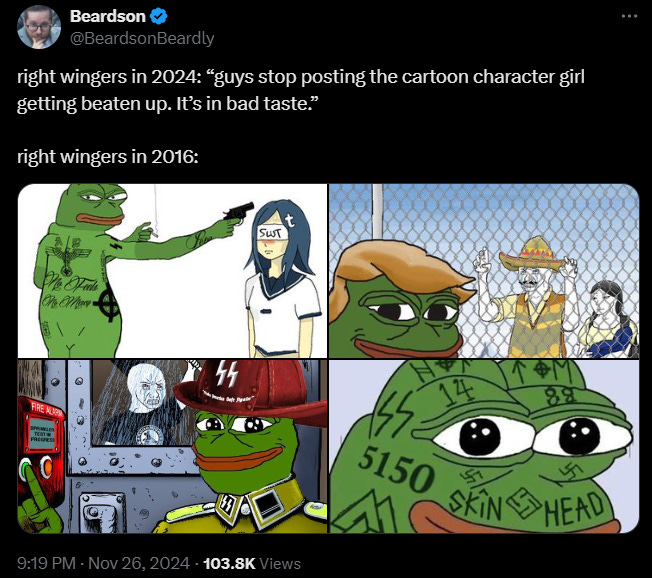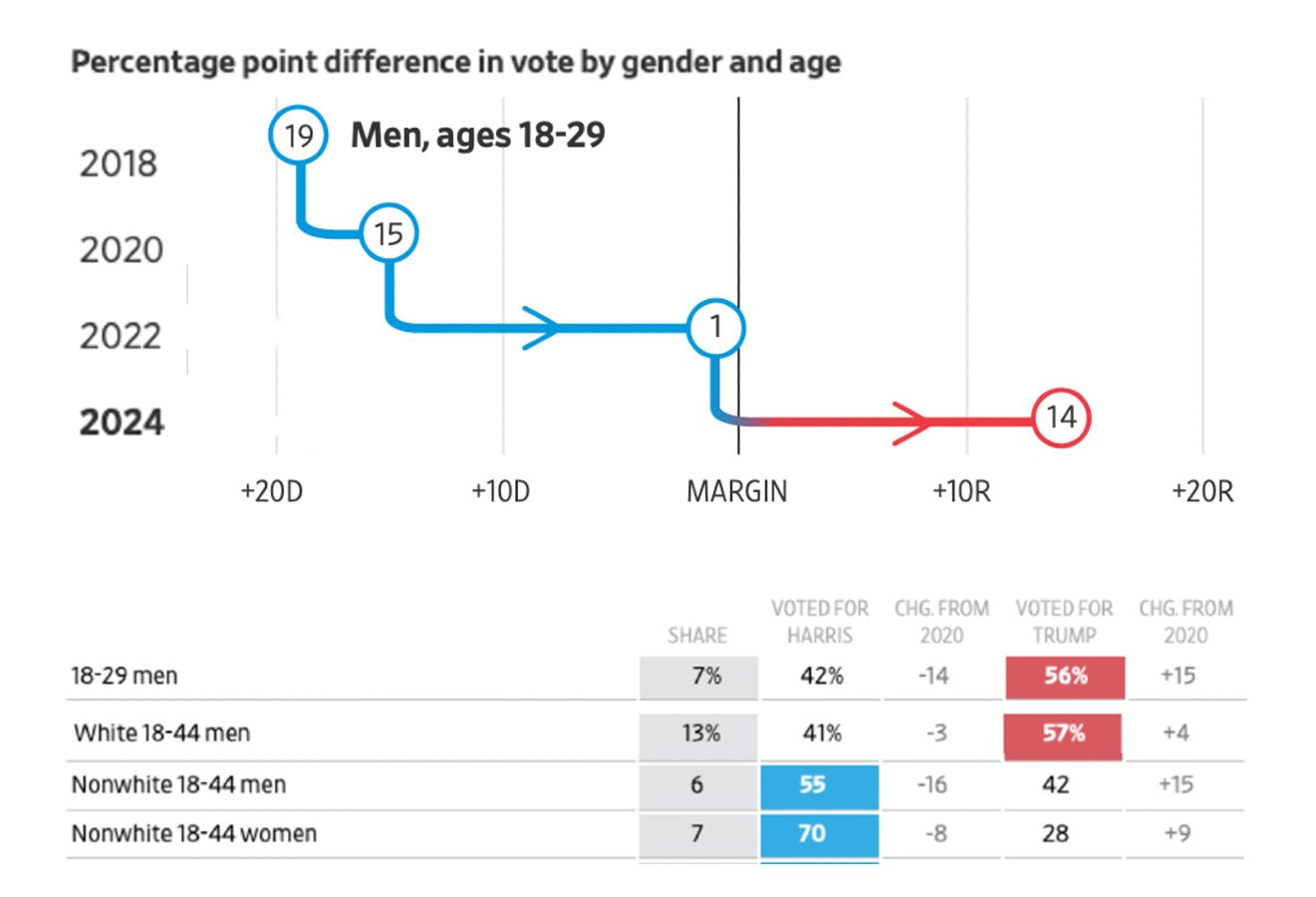The Normie-ification Right
Compared to 2016, the Trump of 2024 appeared to be far less disruptive and more acceptable to the establishment.
Nevertheless, the Right projected onto Trump what they wanted to see in him. Trump the man had been completely overshadowed by Trump the American icon. It did not matter what his actual policies were. His image as the anti-establishment hero of the people overcoming constant persecution by a corrupt system had been permanently cemented by the indictments and attempted assassination. Furthermore, his newfound acceptance by the elites meant that it was easier for average people to support him without facing social backlash. Easily defeating all of his Republican rivals—such as Ron DeSantis—without even so much as attending any of the primary debates, he was now the undisputed master of the Republican party.
During the campaign, few dared to criticize Trump online. Even the slightest criticism was met with accusations that you were helping Kamala to win. This may have been because the online Right had been so heavily astroturfed by influence networks such as those of Peter Thiel, or it may have been because the more mainstream influencers were trying to vie for power and influence in light of what was likely to be the next presidential administration, or it may have simply been out of earnest enthusiasm—which after the assassination attempt, had reached higher levels than ever before.
The only exceptions to Trump mania were those that had already gone through the “Trump lifecycle.” This cycle began with Trump hope—where Trump in their mind became the savior of America who would defeat the woke/SJWs/socialism and make America great again, followed by Trump cope—after he fails to meet their unrealistically high expectations, followed by Trump remorse—eventual resignation and disillusion with Trump. Those who had already followed this cycle to its conclusion included Richard Hanania—a former Alt Right race realist writer turned critic of the Right, Richard Spencer—who had supported the Democrats since around 2018, and Nick Fuentes—who finally flipped from a notorious Trump fanboy to Trump skeptic during the 2024 campaign. These three figures became known for “punching right,” trolling Trump supporters, conservatives, the Dissident Right, and the Right Wing writ large. Ironically, attacking the Right from the right—especially in the contrarian and trollish fashion that Hanania, Spencer, and Fuentes frequently employed—was basically the original origin of the term “Alt Right.” Now they had become a sort of “Alt New Right.”
No matter what Trump did or said, no matter how much he cucked on his previous positions, promised to bring in a million new immigrants, sucked up to Israel, or kissed the ring of Republicans that had betrayed him, the New Right would rationalize it away. As in the election of 2016, they created “Gigachad” and “lazer eyes” memes of Trump, portraying him as a powerful far-right god-emperor ruling America with an iron fist and ushering in a new era of “based” prosperity while instigating mass deportations. Unfortunately, these failed to match the version of Trump that now appeared at his rallies—an old man, surrounded by GOP handlers, making Boomer jokes about Hannibal Lecter, telling rambling stories, and dancing to YMCA.
The most influential Right Wing faction online during the election was the “New Right,” which differed substantially from the Alt Right which had dominated the 2016 election online in both in its character and preferred policies. Millennials and Gen Xers comprised the core of both the Alt Right and this New Right, but obviously they had gotten a lot older over the last nine years, making the New Right less youthful and fresh. This was reflected in their memes, many of which were re-hashes of older memes from the last decade, or in general simply seemed less organic. There was less of an emphasis on the gratuitous shock humor and irony of the Alt Right. Their positions had also softened.
From “Politically Incorrect” to Political
The “Politically Incorrect” attitude of the Alt Right was a reaction to accusations of homophobia, racism, anti-Semitism, and misogyny which had been widely applied to everything from edgy jokes, to unfortunately chosen but well-intentioned words, to mere discussions of sensitive topics. The Alt Right provoked others with intentional and deliberately over-the-top homophobia, racism, anti-Semitism, and misogyny, made either ironically for the sake of shock humor, or “meta-ironically” with some degree of sincerity. Its successor, the Dissident Right, toned down the shock humor a tad, but continued to question the narratives surrounding homophobia, racism, anti-Semitism, and misogyny in a more substantial but still provocative manner. Compared to its predecessors, the New Right was significantly more “safe,” and barely engaged in substantially challenging these taboo issues.
Homophobia -
While BAP and adjacent accounts used words like “gay” in a derogatory way at times, the New Right seemed to have no problem with LGBT. This is probably because social conservatism was not really an important part of their belief system. In the New York “Dimes Square” scene, New Right figures like Curtis Yarvin openly mingled with and promoted open transsexuals such as “Pariah the Doll,” as seen in this photo.
Pariah the Doll was also featured in Passage Publishing’s Man’s World.
When certain accounts on the Dissident Right started protesting this as a betrayal of Right Wing values, BAP, the Red Scare girls, and others defended Pariah the Doll.
BAP then claimed that caring about the issue was essentially purity spiraling and “not right wing.”
A lot of people come on here to try to convince others that they are virtuous and religious people. This isn’t “right wing”—this is someone who has puffed up into an image that’s been successfully (and often unfortunately accurately) precaricatured, and failure is inevitable.
— Bronze Age Pervert, May 13 2024 (https://x.com/bronzeagemantis/status/1790218293393121422)
While the New Right had no problem with open transsexuals in the movement, they did take issue with far-right Trump 2016 loyalists such as John McEntee and Project 2025, judging from the below Twitter post by BAP.
Project 2025 like the fake Kanye campaign was another mirroring attempt meant to sabotage Trump. Run by NeverTrump GOP, it served up on platter the centerpiece of Kamala’s vote drive effort just as now the same people are trying to provide pretext for leftist gender agitation. Trump didn’t care and ignored this bait as well as wisely disavowing Project 2025. Abortion, porn, “reproductive health” etc are just not Trump concerns, they’re the concerns of Mike Pence and Heritage Foundation. The fact it didn’t work doesn’t mean this wasn’t the intention—most of boomer GOP is incompetent at this kind of PR…Kanye was a flop too when right wing youth recognized and rejected it as millennial fashion and consultant-quaint “schizo.”
— Bronze Age Pervert, Nov 10 2024 (https://x.com/bronzeagemantis/status/1855619800158146786)
Racism -
Racism was still a part of the New Right, although the messaging was slightly different than before.
It was not uncommon for New Right accounts to use words like “brownoids” or “nons” (short for non-whites) in a derogatory manner. In fact such pejoratives were frequently used against Nick Fuentes by his enemies in the New Right (since he is of partial Mexican decent) when he defended the pro-Palestinian protesters (many of whom were of Arab or Levantine descent).
A good example of this was New Right accounts, such as “End Wokeness,” flooding Twitter with videos of black people engaged in criminal activity, anti-social behavior, or simply acting crass, often with captions along the lines of “it’s always the same demographic who does this.”
However, the function of these racial posts seemed to primarily be flaunting political correctness or “wokeness,” with the substance of such memes amounting to a soft form of race realism at best.
White Identarianism existed to a degree. Nevertheless, the orientation of this tended to be decrying “reverse discrimination” against whites, or affirming that white people should not be ashamed of their identity. Whites organizing on the basis of their race in order to advocate for a shared political agenda based on their racial interests, let alone white nationalism, was not a part of the message. In practice, the New Right seemed to support a form of civic nationalism and rejection of affirmative action in favor of a meritocracy. This flavor of white identity was far closer to Steve Sailer than it was to Jared Taylor.
While for the sake of truth I think facts about racial disparities should be discussed, it’s not good at all politically. In fact it’s impossible in the present circumstances. Only a myth of race blindness is workable. You won’t convince some populations that they are inferior by birth and deserve their station in life. You won’t even convince “decent people” from high achieving populations of this. On the other hand discrimination to offset perceived past discrimination or natural inequalities is also felt to be wrong (although I think it would be relatively easy to convince modern populations to accept affirmative action to offset natural inequalities, which is another reason pushing this with a political intention is a big mistake). The only solution in short run is race blindness, stopping and reversing all racialization of politics and society. This isn’t my own preference by the way but a statement on fact. The “HBD position” is an impossibility politically and culturally today. Public hypocrisy is the only way out that will be accepted unless you are ready to go the Nietzsche and Gobineau route (and you are not).
— Bronze Age Pervert, Jan 2 2024 (https://x com/bronzeagemantis/status/1742265449423810912)
anti-Semitism -
As covered at length in an earlier article, the online Right was split over Zionism. The establishment Right, as well as a majority of the “New Right,” was either explicitly pro-Zionist or simply did not address the issue at all, while a small minority was anti-Zionist. So, it can hardly be said that the New Right was as a whole anti-Zionist, let alone anti-Semitic. This is in contrast to the earlier Alt Right, wherein anti-Zionist and anti-Semitic memes were widespread.
Misogyny -
When Angela Nagle wrote her book on the Alt Right in 2017, Kill All Normies, much of the book was spent documenting the connection between the Alt Right and “the manosphere,” incel culture, and GamerGate—all of which she characterized as extremely misogynistic.
Years before the whole 4chan troll culture became a central force behind the entire aesthetics and humor of the alt-right, it was teeming with racism, misogyny, dehumanization, disturbing pornography and nihilism.
…
In a 2016 essay ‘The New Man of 4chan’, I wrote an account of the racist and misogynist incel mass shooter Chris Harper Mercer, whose killing spree killed nine and injured nine. In response to a 4chan thread believed to have been started by him, describing a killing that the author was going to commit, a commenter wrote: ‘Make sure you got molotovs. It is really easy and painfully [sic] way to kill many normies.’ Another wrote that ‘Chads and Stacy’s’ should be targeted, referencing a 4chan meme about the normies. Chad Thundercock and his female equivalent, Stacey, are embodiments of this normies meme.
— Angela Nagle, Kill All Normies: Online Culture Wars from 4chan and Tumblr to Trump and the Alt-Right, Zero Books, 2017, pp. 90-91.
4channers regularly called women “cumdumpsters,” replied to any poster identified as a female with “tits or GTFO” (post your tits or get the fuck out), and ironically (or meta-ironically) idolized incel woman-murderers such as Elliot Rodger, who they referred to as “the supreme gentleman” after a video he posted in which he referred to himself as such. The Alt Right, which grew directly out of 4chan culture, brought this tradition with them.
The New Right, in contrast, tried to present themselves as being pro-family. This supposedly positioned them rhetorically in opposition to the Left, which promoted promiscuity, contraception, and LGBT—all said to be “anti-family.” Granted, many of the New Right’s greatest influencers, as noted above, were in fact perfectly fine with promiscuity and LGBT and even described being against it as “cringe purity spiraling.” But for their rank-and-file followers, it was a different story. Some were themselves family men, such as Gab creator Andrew Torba (who as a still-loyal Trump supporter began to pivot away from Trump-critical factions on the online Right such as the Groypers). In other cases, they were men who were single, young, and lonely, and who were finding it increasingly difficult to start a family. There was also a racial angle to the pro-family position. More white families meant more white babies.
Over time, this pro-family position became an anti-misogynist position. The pro-family New Right began to push back against misogynistic posts, characterizing them as attacks on “white women,” and thus attacks on the traditional family. They even began to attack Right Wingers who displayed misogyny as “incels.” Once, it had been the online Right who had been called “incels” by online Leftists. In the earlier days of the Dissident Right, some had even self-identified as “incels” as an attempt to “re-appropriate” the term from feminists. Now, it was being levied by the New Right as an insult in much the same way as the feminists had once done.
This change in position was perfectly exemplified by the “Wifejak” meme, which went through several waves of popularity throughout 2024. The first major wave occurred in April 2024, and the second occurred in November 2024 shortly after the election.
Wifejak, sometimes misspelled Wifejack, is a Wojak variant depicted as a woman with long red hair, a grey sweater, a necklace and freckles that's typically used in memes to portray a stereotypical wife. The character was designed by Redditor u/AvaSpelledBackwards in 2021 and was first used as a meme alongside a caption representing the stereotypical wife as early as July 2022 on X / Twitter, becoming notably popularized on the site in April 2024.
…
While the first known use of the character as "wifejak" is unclear, the earliest known example was posted by X user PaulSkallas on July 17th, 2022. On that day, they posted the image of Wifejak under the caption, "Where are we going this weekend?" meant to represent a typical question that a wife might ask, garnering over 360 likes in two years.
— Know Your Meme, “Wifejak” (https://knowyourmeme.com/memes/wifejak)
Wikejak originally satirized typical things that a wife or girlfriend might do or say.
However, as time went on, the meme began to transform into a wholesome and romanticized version of the domestic life. Posters began to transition from satirizing their significant others to merely simping for Wifejak.
Posters began to self-insert as “Husbandjak” and created spinoff characters such as “Daughterjak” until they had created a complete imaginary meme family, doing typical imaginary meme family activities.
Others, particularly the Groypers, began to attack Wifejak as cringe, unfunny, and simply a stealth way of simping for women. They considered this a betrayal of the Internet Right’s traditional misogynistic values. As a result, they began posting their own anti-Wifejak memes.
The Wifejak posters in turn called the Groypers incels, and claimed that they were “anti-white” and trying to discourage white people from having families.
According to a large segment of the New Right, misogyny was no longer on the table.
“Wifejak” was essentially a “normie meme”—exactly the type of thing that had once been derided by 4chan as “too reddit” (the equivalent of calling someone a “poser” in online culture). The origin of Pepe the Frog’s association with the Alt Right had been an intentional campaign by 4chan to prevent Pepe from becoming one of these dreaded “normie memes” by associating him with what in the eyes of the normies amounted to “Internet Nazis” (covered in “A Normie’s Guide to the Dissident Right Part 3”). In contrast, the humor of Wifejak was essentially “so relatable content”—the epitome of a normie meme.
This in turn created weeks of discourse on the Internet over Wifejak, the backlash to Wifejak, and the backlash to this backlash. Those who saw the meme as cringe said that it was a sign that the Dissident Right was dead, by comparing its wholesome content to the incel-inspired misogyny and general shock humor of the Alt Right of nearly a decade before.
Appeal to Normie
The discourse over Wifejak led to another debate: if right wing culture had become indistinguishable from normie culture, was this a good thing or a bad thing?
While its roots lay in the Alt Right and Dissident Right, the New Right had become “normie”-fied. The Alt Right was mostly full of autistic, anti-social misfits from 4chan. After Charlottesville, discussions over “optics” caused the online Right to gravitate away from this, and instead to try to appeal to “normies.” During the Dissident Right Era, the Right pivoted to trying to draw a distinction between themselves, who were the “true” normies, and the woke blue-haired, pronoun-using “freaks” of the Left— which could only be accepted as normal in “Clown World”. This rhetorical framing eventually became known as “appeal to normie.”
From this time on, the Right was always trying to signal how normal they were, in spite of their interests in obscure, esoteric Internet politics. By 2024, “normie memes” such as Wifejak seemed to indicate that the Right had finally gotten its wish.
Some argued that this was a good thing. After all, didn’t the Right want its political ideas to spread until they eventually became the norm? Wasn’t that the whole point of trying to “redpill the normies?”
Others said that it meant that the Dissident Right had become diluted and softened to the point where its culture and ideas were virtually the same as that of the old Right that had come before it, and which the Alt Right had tried to distinguish itself from back in the days of Trump 2016 and the Great Meme War.
The question is still an open one. Many, including myself, had long predicted that a synthesis between the Alt Right and what had come before it was inevitable. Was this it? Or was this a step in the opposite direction—a sign that the status quo had absorbed the blow and neutralized the threat posed to it in 2016?
Had the Right become cucked, or had normies become based?
Based Gen Z
I meet a group of college students at my local church. They invite me over to make tacos. We go to the grocery store, and they check the backs of the packages on all the food. They’re trying to make sure they don’t have any “seed oils.”
As we walk around the grocery store, it reminds of a video where Frank Hassle trolls people by taking items out of their shopping carts and walking off with them. (Frank Hassle is a YouTuber who frequently collaborates with Sam Hyde.)
“Is that the guy from Fish Tank?” they ask me.
We make our way back to the house. One of their roommates meets us at the door.
“WHAT UP MY NIGGAZ?!?” their white roommate says in an obnoxiously loud voice.
We say grace over the food, and they tell me about a wrestling club they’re starting at the church. They explain in very Jordan Peterson-esque terms the importance of teaching young men discipline and building male spaces.
“It’s not just about getting fit. A lot of men are really lost out there,” they say. “We need to learn to be strong—both body, mind, and soul.”
The guys all use Right Wing Internet slang that was forged in the deep recesses of 4chan many years ago. For example adding the suffix “-cel”, “-maxxing” or “-chad” to the ends of words—all slang that derived directly from 4chan incel culture.
-cel
A suffix uder to denote the reason a person is experiencing inceldom. For example height-cel (too short), ethni-cel (ethnic discrimination), fat-cel (too obese to be lovable)
he appeared to be a location-cel
by invert cattso January 8, 2019
— Urban Dictionary (https://www.urbandictionary.com/define.php?term=Cel)
Maxxing = working or doing something to the maximum. Simpmaxxing = being a big simp
Cel = suffix meaning attraction/addiction/ or generally just being a part of a group that likes a topic.
— Reddit user zman245, Jul 18 2023 (https://www.reddit.com/r/NoStupidQuestions/comments/15341cb/comment/jsh4hhl/)
A Chad, in modern internet slang, is generally a sexually active "alpha male". The term has become a slang term across the internet and among adolescents in general to refer to particularly attractive or confident males.
The man who wrote this meaning is a chad.
by keanugriffinchungus December 21, 2021
— Urban Dictionary (https://www.urbandictionary.com/define.php?term=a%20chad)
Their tastes, manner of speaking, and shared culture is obviously downstream from the Dissident Right in the same way that Boomer tastes, manner of speaking, and shared culture is in many ways downstream from the hippie counter-culture—just as I predicted in the early 2010s when I had just started browsing /pol/. To me, all of these 20-something young men seemed like an amalgamation of Bronze Age Pervert, Sam Hyde, and the Groypers.
This is anecdotal, but I am not alone in this sort of observation. In fact, it is so prevalent that it has almost become trite to observe.
It was a lot of fun to watch young men vote for Trump, because I got to see it unfold firsthand. I know a lot of male Zoomers, just by virtue of the fact that I happen to be one myself.
People in our line of work spend a lot of time dissecting and debating voting trends, but it's often abstract — just another set of numbers on an exit poll. Here, though, I saw it happen on the ground; I knew it was happening before it ever started showing up in the polls.
You can tell a lot about the political mood of a demographic by the way its apolitical members think and talk. The hyper-political types — on both sides of the aisle — are going to have strong opinions on any number of issues. It's the guys who don't pay attention to politics that can tell you about the general prevailing attitudes. Since they're not interested in politics themselves, they've just absorbed their demographic's broader political culture.
When I started meeting those guys everywhere — guys who didn't know the first thing about politics, but still knew that they loved Trump and hated liberals — was when I knew there was a fundamental shift happening.
Anyone who regularly interacts with Gen Z boys — the normal, not-especially-political ones — can tell you what I mean: It's not just that their specific political views are more right-wing. (Although they are). It's that they are more right-wing, at the most core level. It's in the jokes they tell, the podcasts they listen to, the things they praise or consider "cool" versus the things they mock or deride — it's a very fundamental shift that goes beyond any one specific issue. And it's not going to go away anytime soon.
— Nate Hochman, Nov 22 2024 (https://x.com/njhochman/status/1860122956804030914)
Nate Hochman is a senior advisor at America 2100. He is also a columnist for the American Spectator, with writings featured in publications such as The American Conservative, City Journal, The Claremont Review of Books, National Affairs, National Review, and The New York Times.
This shift in the culture, however, is different from that of the Boomers in one important way: it seems to be a phenomenon that is only occurring with males. American men are becoming much more conservative, but women continue to be much more liberal. And this is true not only in America, but throughout much of the world.
Although it may seem obvious why this would be the case—we can see how an anti-feminist, patriarchal movement that is in some ways adjacent to incel culture might not appeal to women—this was not necessarily a given. Ten years ago, the early Alt Right had several prominent female influencers, such as ShoeOnHead, Brittany Venti, and Lauren Southern.
Be that as it may, even if in many ways the online Right has been “normie”-fied, and even if Trump 2024 may be cucked compared to Trump 2016, and even if Trump’s second term may not be a political victory per se for political dissidents—the cultural victory has indeed been won. The Dissident Right has won the argument. /pol/ has won the debate. At least, when it comes to men.



